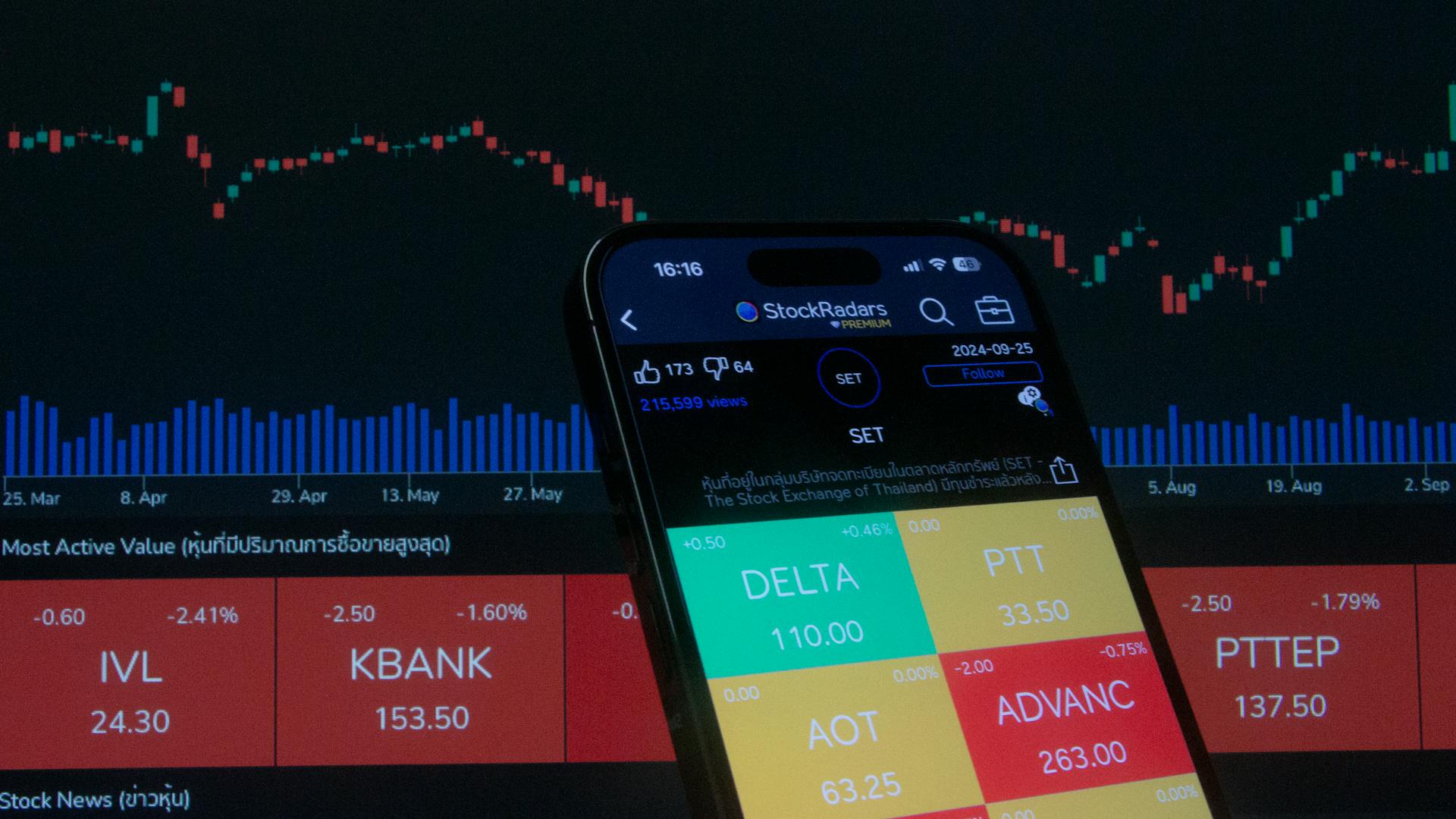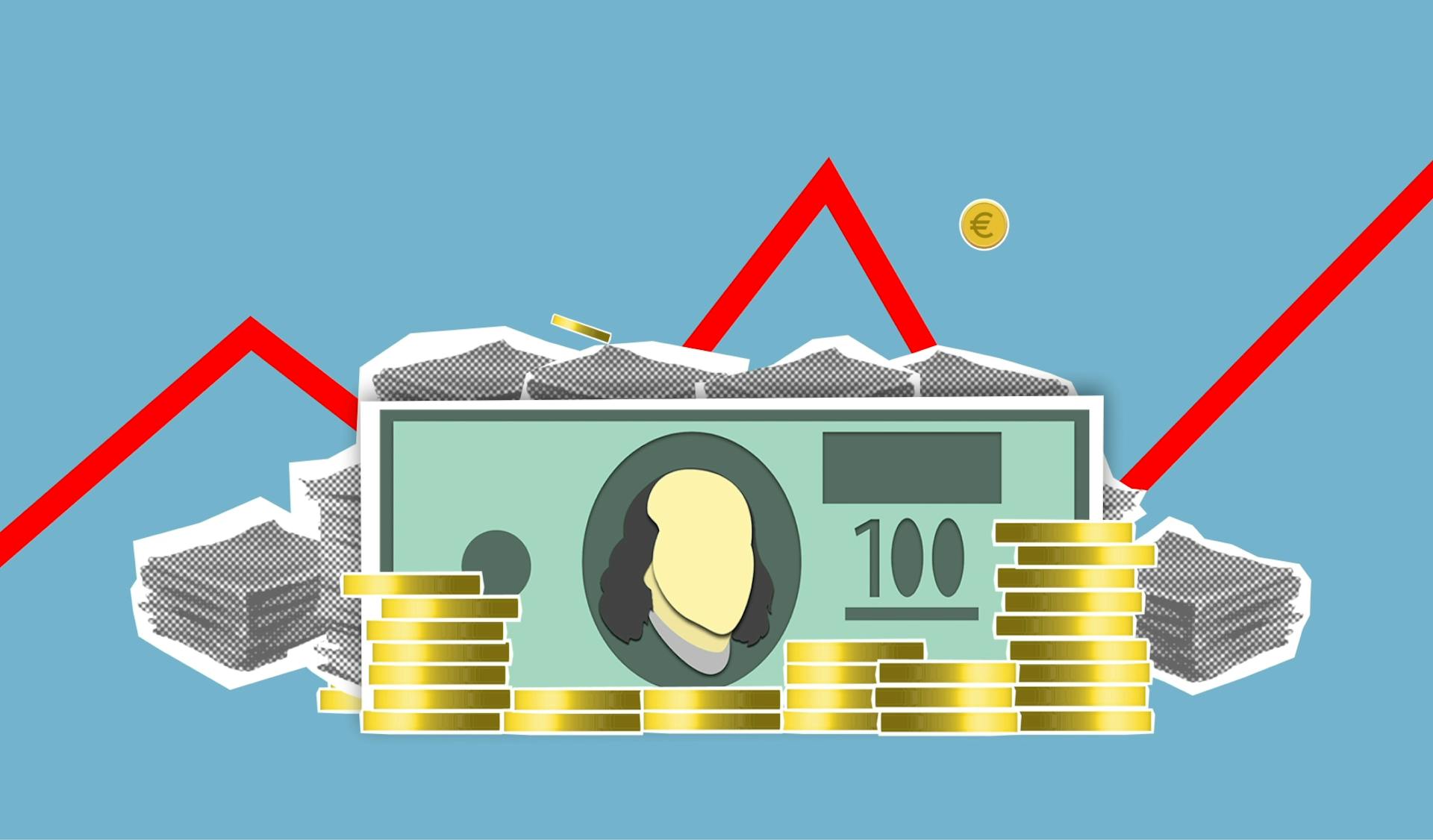
Financial capital is a crucial element for business growth. It refers to the funds used to invest in a business, which can be obtained through loans, investments, or savings.
Having sufficient financial capital allows businesses to take calculated risks, invest in new projects, and expand their operations. This, in turn, can lead to increased revenue and profitability.
Businesses can access financial capital through various means, including loans from banks or other financial institutions, investments from venture capitalists or angel investors, or by retaining a portion of their profits.
Discover more: UK Financial Investments
Financial Instruments
Financial Instruments are the tools businesses use to raise funds. They can be broadly classified into two main categories: equity and debt.
Equity is a type of financial instrument where a business receives a direct investment in exchange for ownership. This can be done by issuing stocks or shares of company ownership.
Debt, on the other hand, is a financial instrument where a business borrows money from a creditor. This type of funding does not dilute ownership, but it does create a legal claim on the borrower's assets.
If this caught your attention, see: Business Prepaid Credit Card

Here are the key differences between equity and debt:
Equity capital, which includes direct investments in a business, does not create a legal claim on borrower assets. However, it does dilute ownership and entitle the investor to a proportional share of future profits.
See what others are reading: What Does Prudential Financial Do
Financial Markets
The U.S. has the world's largest capital markets, funding 65% of the country's economic activity.
These markets are incredibly transparent, allowing investors to stay up-to-date on every aspect of companies they're considering investing in.
The U.S. bond market is a behemoth, boasting a size 1.9 times larger than the next largest fixed-income market, which belongs to the European Union.
Check this out: Capital Allocation Line vs Capital Market Line
Money Market
The money market is a place where financial institutions can use short-term savings to lend out in the form of short-term loans. This allows them to generate interest income.
Short-term loans are typically used by businesses to cover temporary cash flow gaps or to take advantage of investment opportunities. These loans are usually repaid quickly, often within a few months.
Financial institutions use money market funds to invest excess cash, which earns them interest income. This income is then used to offset operating costs or to increase profits.
Here are some key characteristics of the money market:
- Financial institutions use short-term savings to lend out in the form of short-term loans
Markets
The U.S. has the world's largest capital markets, funding 65% of the country's economic activity. This access to capital is crucial for businesses to innovate and expand.
The U.S. stock market is incredibly transparent, allowing investors to get up-to-date information about every aspect of companies in which they might invest. This transparency is a significant advantage for investors.
The U.S. bond market is a behemoth, 1.9 times larger than the next largest fixed-income market, which belongs to the European Union. This market is serviced by investment banks that underwrite bonds and guarantee their success.
Trading between national currency instruments is conducted on a money market, revealing differences in the probability of debt collection or store of value function of that currency, as assigned by traders. This trading is a key indicator of a currency's reliability.
Financial instruments can be traded on bond markets or reinsurance markets, with varying degrees of trust in the social capital of bond-issuers, insurers, and others who issue and trade in these instruments.
For more insights, see: Do S Corps Pay Corporate Taxes
Financial Concepts

Financial capital is a fundamental concept in business, referring to saved-up financial wealth used to start or maintain a business. It's often synonymous with the net assets or equity of an entity.
There are three main concepts of capital maintenance under International Financial Reporting Standards (IFRS): physical capital maintenance, financial capital maintenance in nominal monetary units, and financial capital maintenance in units of constant purchasing power.
Financial capital can be provided by lenders in exchange for interest, and it's also a liquid medium or mechanism that represents wealth. It's essentially purchasing power in the form of money available for the production or purchasing of goods.
Financial capital can be categorized into different types, including economic or "productive capital" necessary for operations, signaling capital that signals a company's financial strength to shareholders, and regulatory capital that fulfills capital requirements.
Some businesses use specialty capital, such as supply chain financing, which is like a payday loan for businesses. Banks lend the company the amount of an invoice, minus a fee, and receive payment for the loan when the invoice is paid.
Financial capital can also be obtained by producing more than what is immediately required and saving the surplus.
Here's an interesting read: What Is a Secured Business Loan
Financial Structure
A company's financial structure is a vital aspect of its overall health. Most public companies use a combination of debt and equity to create and manage their capital.
The debt-to-equity ratio is a simple formula used by many analysts to determine a firm's solidity. Companies with a ratio of 50% or more are considered highly leveraged and riskier.
A company's working capital is the cash on hand needed to run its operations. To find a company's working capital, you subtract current liabilities from current assets.
A working capital ratio of 2:1 indicates a company has enough liquidity to meet its present needs.
A different take: Growth Capital Company
Financial Analysis
Financial Analysis is a crucial aspect of understanding financial capital. Valuations of financial instruments can vary drastically based on timing, which can lead to discrepancies in their unit of account functions.
The "book value" convention is one approach to reconciling financial capital value units of account, but it's not always the most accurate method. In some cases, the "mark-to-market" convention is used, which values an instrument at its current market price.
The "mark-to-future" convention, on the other hand, values an instrument at its expected future price, which can be a more forward-thinking approach. This convention can be particularly useful for complex financial instruments with uncertain future values.
Broaden your view: Uti Asset Management Share Price
Financial Management
Financial Management is all about making the most of your financial capital. Financial capital is a broader term than economic capital, and it's anything that has a monetary value and is used to pursue future revenue.
Financial capital is commonly viewed as debt or equity, which means it can come in the form of loans or investments.
Financial Learning
Firms need financial capital to make big decisions, like buying a machine or building a new plant. This capital can come from early-stage investors, reinvesting profits, borrowing, or selling stock.
Borrowing through banks or bonds is a common way for firms to raise capital. Firms can distinguish between bonds and bank loans as methods of borrowing, understanding the implications for operations and profits.
Firms can also choose to sell stock to raise capital. This means they're giving up ownership in their company, which can have implications for their operations and profits.
To make informed decisions, firms need to understand the different sources of financial capital. Here are four main ways firms raise capital:
- From early-stage investors
- By reinvesting profits
- By borrowing through banks or bonds
- By selling stock
Each financial option has different implications for the business in terms of operations and profits. Firms need to carefully consider these implications when making decisions about raising capital.
Debt
Debt can be obtained through various financial and non-financial sources, including commercial banks, credit unions, and finance firms.
Firms can also obtain debt through inter-enterprise credit between other businesses, informal marketplaces, and governments.
Debt is a form of deferred payment for resources, whether monetary or goods or services, with lenders expecting repayment plus interest.
In extreme difficulties, especially when interest payments are missing, ownership and control can revert to the creditors, who may seize the corporation and liquidate it as a form of recovery.
The legal instrument that creates the lender-borrower relationship has significant enforcement power, allowing creditors to take control in such situations.
A firm can raise debt by issuing corporate debt in the form of bonds, which is a common way for companies to access financial capital.
Expand your knowledge: Alternative Asset Firms
Financial Overview
Financial capital is the monetary assets required for a business to provide goods and services. This is the foundation of any business, and it's essential to have enough financial capital to cover operational costs.
Check this out: Business Credit Cards That Pull Experian

Financial capital is commonly viewed as debt or equity. These two sources of funding are the most common ways businesses raise capital.
To put this into perspective, think of it like starting a small business. You may need to take out a loan (debt) or ask investors for funding (equity) to get your business off the ground.
Related reading: Financing with Equity
Economic Overview
In the world of business, it's essential to understand the difference between financial capital and economic capital. Financial capital is the monetary assets required for a business to provide goods and services, calculated through risk management strategies.
Financial capital is often used to cushion a business from losses, making it a crucial aspect of risk management. This is why financial capital is commonly calculated to determine the amount of capital a business needs to absorb potential losses.
Financial capital should not be confused with the economics term capital, which refers to one of the four factors of production that drive supply. In economics, capital includes durable goods such as machinery, equipment, and tools.
Suggestion: Financial Risk and Non Financial Risk
These durable goods are used to create other products, making them a vital part of the production process. Sometimes financial capital is called the fifth factor of production, but that's not exactly accurate.
Financial capital makes production possible by providing income to the owners of production, rather than being a separate factor of production. This distinction is essential to understand the role of financial capital in the economy.
Here's a quick breakdown of the four factors of production in economics:
- Machinery, equipment, and tools (durable goods)
- Land
- Labor
- Entrepreneurship
Note that financial capital is not included in this list, but rather plays a supporting role by providing income to the owners of production.
Key Takeaways
Financial capital is the monetary assets required for a business to provide goods and services. This includes the funds needed to purchase equipment, rent office space, and pay employees.
Economic capital is the capital needed to cover the company in case of loss. This is often referred to as a safety net to prevent the business from going bankrupt.
Financial capital is commonly viewed as debt or equity. This means that businesses can obtain financial capital through loans or by selling shares of the company to investors.
See what others are reading: Western Asset Management Company
Frequently Asked Questions
What does capital mean in finance?
In finance, capital refers to the money a company needs to operate and grow, including cash, accounts receivable, and long-term assets. Understanding capital is crucial for businesses to make informed decisions about investments and growth.
Sources
- https://en.wikipedia.org/wiki/Financial_capital
- https://www.investopedia.com/ask/answers/031715/what-difference-between-financial-capital-and-economic-capital.asp
- https://www.thebalancemoney.com/what-is-financial-capital-3305825
- https://courses.lumenlearning.com/wm-introductiontobusiness/chapter/how-businesses-raise-financial-capital/
- https://www.wallstreetmojo.com/financial-capital/
Featured Images: pexels.com


